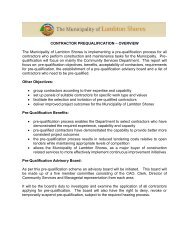View - The Municipality of Lambton Shores
View - The Municipality of Lambton Shores
View - The Municipality of Lambton Shores
You also want an ePaper? Increase the reach of your titles
YUMPU automatically turns print PDFs into web optimized ePapers that Google loves.
Watson & Associates Economists Ltd. 9.<br />
7. METHODOLOGY AND APPROACH<br />
<strong>The</strong> Development Charges Act, 1997 provides a specified number <strong>of</strong> steps, which must be undertaken in<br />
the calculation <strong>of</strong> a development charge. Figure 7-1 diagrammatically illustrates our firm’s understanding<br />
<strong>of</strong> the methodology required. A brief discussion is provided below:<br />
Step 1 involves estimating the anticipated amount, type and location <strong>of</strong> development for which<br />
development charges can be imposed. This estimate is needed for the first two five year periods and<br />
then to the end <strong>of</strong> the planning period. Annual estimates do not appear to be mandatory.<br />
Step 2 involves the exclusion <strong>of</strong> all ineligible services from the calculation, as any expenditures in this<br />
area must be made from the tax base, user rates, etc.<br />
Step 3 requires that “the increase in the need for service attributable to the anticipated development...be<br />
estimated for each service” that is involved. This replaces the “growth-related net capital cost” reference<br />
in the old Act. This estimate does not appear to require project-specific consideration at this stage as it<br />
refers to “need” and not to “project solutions” or the means by which such needs are to be met. It may<br />
therefore be appropriate to address it in terms <strong>of</strong> “service units.” <strong>The</strong>se are the same factors that can be<br />
used to measure past and future levels <strong>of</strong> service in a subsequent step.<br />
Step 4 is to ensure that the increase in need included in Step 3 does “... not include an increase that<br />
would result in the level <strong>of</strong> service (for the anticipated development increment) exceeding the average<br />
level <strong>of</strong> that service provided in the <strong>Municipality</strong> over the 10-year period immediately preceding the<br />
preparation <strong>of</strong> the background study. O.Reg. 82/98 (s.4) goes on to indicate that “... both the quantity<br />
and quality <strong>of</strong> a service shall be taken into account in determining the level <strong>of</strong> service and the average<br />
level <strong>of</strong> service.”<br />
Step 5 requires that for an increase in need to be included in Step 3, Council must indicate that it intends<br />
to ensure that such an increase in need will be met, presumably in accordance with the timing periods<br />
established in Step 1. Once again, this would appear to be a broad, need-related approval and not<br />
necessarily a long range capital budget approval.<br />
Step 6 calls for an examination <strong>of</strong> the long term capital and operating costs for capital infrastructure to be<br />
included in the development charge background study and considered by Council before passing a DC<br />
by-law. Ideally, this information would be available to Council when it takes Step 5, but this does not<br />
appear to be a requirement and is dependent on the timing <strong>of</strong> the steps in the process. Steps 3 and 5<br />
are early steps and Step 6 could occur later.<br />
Step 7 involves removing from the DC calculation those kinds <strong>of</strong> local services for which the <strong>Municipality</strong><br />
can impose directly or indirectly a charge related to a development or a requirement to construct a<br />
service related to a development, by way <strong>of</strong> a condition or agreement under Section 51 or 53 <strong>of</strong> the<br />
Planning Act. It also involves ensuring that appropriate policies are established such that those services<br />
are, in fact, addressed subsequently in that fashion and are neither double-counted nor omitted.<br />
H:\PROPOSAL\<strong>Lambton</strong> <strong>Shores</strong>\2012 DC W&WW\DC\<strong>Lambton</strong> <strong>Shores</strong> 2012 DC.docx<br />
189
















